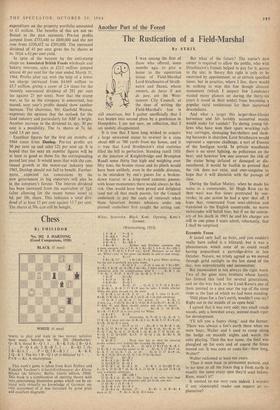Chess
By PHILIDOR
No. 202 J. HARTONG (Good Companions, 1920) BLACK (5 men) WHITE (6 men) WHITE to play and mate in two moves; solution next week. Solution to No. 201 (Heathcote): Q—R 6, threat R—Q 1. 1 R—K 5 ch; 2 B—Q 4.
. . . P—Q 4 ch; 2 B—B 5. 1 . . . R—Kt 2 ch; 2 B—Kt 6. I . . . P= Q;.2 12.,,I3 3. 1 . . . K---K 8; 2 Q—R I. The try 1 R—Q I ch is defeated by 1 . . . P x R = Kt. A masterpiece.
This week's game is taken from Kurt Richter and Rudolph Teschner's Schach-Eraffnungen: der Kleine Magner (de Gruyter, Berlin, fourth edition, 1964). This book is a combination of opening theory with very_entertaining illustrative games which can be en- joyed with virtually no knowledge of German; my own enjoyment of it was increased by good print and excellent diagrams. White, SCHUS TER. Black, KARL. Opening, KING'S
GAMBIT.
(Wurttemberg, 1957)
1 P—K 4 P—K 4
2 P—KB 4 PXP 3 Kt—KB 3 11—K 2 4 B—B 4 Kt—KB 3 5 Kt—B 3 . . Richter and Teschner comment that
a more energetic line is 5 P—K 5, Kt—Kt 5; 6 0-0. Kt—OB 3: 7 P—Q 4, P—Q 4; 8 P xP e.p., QXP. However, as we shall ace, White's play in 'this game can hardly be said to lack energy.
5 . . . KtxP 6 Kt—K 5!? . . 6 Kt x Kt, P—Q 4 gives White nothing, but the text is probably not quite sound.
6 . . . P—Q 4! 6 .0-0; is met by 7 Kt x BPI, R x Kt; 8 BX R ch. K x B; 9 Kt.x.Kt. I leave readers to amuse themselves with the complications after 6 . . . 13—R 5 ch;
7 P--Kt 3, PxP; 8 BxP ch, K—B I; 9 0-0.
7 BxP KtxKt it BXPch I 9 KtPXKt B—Q 3 10 0-0 B x Kt. 10 . . Q—K 2; 11 P—Q 4, BxKt; 12 B—Kt 3, B—B 3; 13 BxP may be safer. 1 doubt whether White has quite enough for the piece.
.11 13—R 3, eh! K XII. If 11. . B—Q 3; then 12 R xP!, Bx11; 13 B—Kt 3 ch, K—K 2; 14. Q—K 2 ch with advantage. 12 Q—R 5 ch, K—H 3, Tot greedy. 12K—Kt 11 is best, e.g.. 13 QX R, Kt —B 3; 14 Q—K 4 (14 QxP?, B—K 3!), P—KKt 4!, and Black should survive and win—in theory.
13 QR—K 1 Bz—B 4. 13 . . . Kt—B 3; 14 R XIII, Kt X R; 15 R xP eh is also good for White, 14 RxB I KxR
15 Q—B 71 . . . threatening 16 P—Q 4 ch. K—K 5;
17 R. —K 1 mate and also 16 R—K 1 ch, B—K 5; 17 R X B eh!, KxR; 18 Q—K 6 mate.
15 . . . QxP or 15 . . Kt—B 3; 16 R—K I ch, B—K 5; 17 R x13 ch. K xR; 18 Q—K 6 ch, Kt—K 4; 19 P—Q 3 ch, K—K 6; 20 B—B I ch, K—K 7; 21 QxKt ch, K—Q 8; 22 QXKIIP, KxP; 23 Q—Q 2 ch, K—Kt 8; 24
Q —Kt 2 mate. •
It B—B t! . . . Black now has to shed his material
profits without ever looking like escaping the attack. 16 . . . Q x B. 16 ... Q—Q 4; 17 B xP ch, K—K 5; 18 R—K I ch winning queen or 16 . . . Q—K 7; 17 BxP ch, K—K 5; 18 Q—K 7 ch, or 16 . • . 111-4, 2; 17 13XP K--K 5; 18 Q-13 4 ch, Q—Q 5 ch; 19 Q xQ mate.
17 R xQ Kt—I3 3 18 R—K 1 ch B—K 5 IS QXKtP ch K—Q 4
20 Q—B 7 ch K—,13 4. 20. . K—K 4; 21 QxQB P ch. K—Q 4; 22 Q—B 7 ch, K—K .4; 23 Q—R 5 ch and 24 RxB with a winning advantage.
. 21 Rx13 OR—QB 1
22 Q—B 4 ch K—Kt 3. The king is no safer here than on the king's wing—his defenders only get in his own way.
23 Q—Kt 3 ch K—R 3 24 R—R. 4 ch Kt--R 4
25 Q—B 4 ch Resigns. 25 . . . 3; 26 R—Kt 4 mate or 25 .......1<1 4; 26 Q-- B 6 mate.


































 Previous page
Previous page